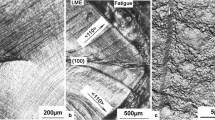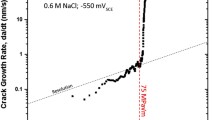Abstract
A mechanism of stress corrosion cracking (SCC) is outlined in which anodic dissolution at film rupture sites relieves strain hardening and reduces the fracture stress at the crack tip. Experimental evidence is cited to suggest that relief of strain hardening occurs by interaction of subsurface dislocations with divacancies generated by the anodic dissolution. A transgranular crack propagates by accumulation of divacancies on prismatic planes which then separate by cleavage under plane strain conditions at the crack tip. At appropriate metallurgical and chemical conditions, anodic dissolution and/or divacancy migration may be enhanced at grain boundaries, leading to an intergranular failure mode. Evidence is also available to indicate that cyclic loading relieves strain hardening. Relief of strain hardening by combined cyclic loading and corrosion accounts for the higher incidence of corrosion fatigue cracking (CFC) without the requirement of any critical dissolved species. Data on fatigue of stainless steel at elevated temperature in both vacuum and air provide additional support for the proposed mechanism.
Similar content being viewed by others
References
D. A. Vermilyea:Stress Corrosion Cracking and Hydrogen Embrittlement of Iron-Base Alloys, R. W. Staehle, ed., National Assoc. Corrosion Engrs., Houston, TX, 1977, p. 208.
R. N. Parkins:5th Symposium on Line Pipe Research, Am. Gas. Assoc., Houston, TX, 1974.
J. C. Scully:Fracture 1977, ICF4, Waterloo, Canada, June 19–24, 1977, vol. 1, p. 407.
R. W. Staehle:Theory of Stress Corrosion Cracking in Alloys, J. C. Scully, ed., NATO, Brussels, 1971, p. 223.
F. P. Ford:Corrosion Processes, R. N. Parkins ed., Applied Science, New York, NY, 1982, p. 271.
T. P. Hoar and J. M. West:Proc. Royal Soc., 1968, vol. A268, p. 304.
T. P. Hoar and J. C. Scully:J. Electrochem. Soc., 1964, vol. 111, p. 348.
D. A. Jones, C. D. Kim, and B. E. Wilde:Corrosion, 1977, vol. 33, p. 50.
R. W. Revie and H. H. Uhlig:Acta Metall., 1974, vol. 22, p. 619.
R. W. Revie and H. H. Uhlig:Corrosion Sci., 1972, vol. 12, p. 669.
H. H. Uhlig:J. Electrochem. Soc., 1976, vol. 123, p. 1699.
M. Smialowski and J. Kostanski:Corrosion Sci., 1979, vol. 19, p. 1019.
M. C. Petit and D. Desjardins:Stress Corrosion Cracking and Hydrogen Embrittlement of Iron-Base Alloys, R. W. Staehle, ed., NACE, Houston, TX, 1977, p. 1204.
H. W. Pickering and C. Wagner:J. Electrochem. Soc., 1967, vol. 114, p. 698.
J. T. Evans and R. N. Parkins:Acta Metall., 1976, vol. 24, p. 511.
C. E. Feltner and G. M. Sinclair:Int. Conf. on Creep, London, 1963, pp. 3–9.
R. N. Parkins: ASTM STP 665, 1979, p. 5.
A. J. A. Mom, R. T. Dencher, C. J. v. d. Wekken, and W. A. Schultze: ASTM STP 665, 1979, p. 305.
R. N. Parkins and B. S. Greenwell:Metal Science, August/September, 1979, p. 405.
R. N. Parkins:Br. Corrosion J., 1979, vol. 14, p. 5.
R. C. Newman, R. Roberger, and R. Bandy:Corrosion, 1983, vol. 39, p. 386.
R. Liu, N. Narita, C. Alstetter, H. Birnbaum, and E. N. Pugh:Metall. Trans. A, 1980, vol. 11A, p. 1563.
R. W. Staehle:Stress Corrosion Cracking and Hydrogen Embrittlement of Iron-Base Alloys, R. W. Staehle, ed., NACE, Houston, TX, 1977, p. 180.
S. T. Rolfe and J. M. Barsom:Fracture and Fatigue Control in Structures, Prentice-Hall, 1977, p. 33–44.
S. T. Rolfe and J. M. Barsom:op cit. Fracture and Fatigue Control in Structures, Prentice-Hall, 1977, pp. 43–46.
D. L. Davidson and F. F. Lyle:Corrosion, 1975, vol. 31, p. 135.
C. Patel:Corrosion, 1980, vol. 36, p. 665.
J. A. Beavers and E. N. Pugh:Metall. Trans. A, 1980, vol. 11A, p. 809.
E. N. Pugh:Atomistics of Fracture, R. M. Latanision and J. R. Pickens, eds., Plenum, New York, NY, 1983, p. 997.
E. I. Meletis and R. F. Hochman:Corrosion, 1984, vol. 40, p. 39.
B. E. Wilde and C. D. Kim:Corrosion, 1972, vol. 28, p. 350.
T. R. Pinchback, S. P. Clough, and L. A. Heldt:Metall. Trans. A, 1976, vol. 7A, p. 1241.
A. J. Forty:Physical Metallurgy of Stress Corrosion Fracture, T. N. Rhodin, ed., Interscience, New York, NY, 1959, p. 99.
M. A. Myers and K. K. Chausla:Mechanical Metallurgy, Prentice-Hall, Englewood Cliffs, NJ, 1984, p. 373.
J. D. Verhoeven:Fundamentals of Physical Metallurgy, Wiley, 1975, p. 158.
M. Takano:Proc. 5th Int. Cong. Metallic Corrosion, NACE, Houston, TX, 1974, p. 355.
B. F. Brown, C. T. Fujii, and E. P. Dahlberg:J. Electrochem. Soc., 1969, vol. 116, p. 218.
H. Coriou, L. Grall, C. Mahieu, and M. Pelas:Corrosion, 1969, vol. 22, p. 280.
D. Lee and D. A. Vermilyea:Metall. Trans., 1971, vol. 1, p. 2565.
D. J. Duquette and H. H. Uhlig:Trans. ASM, 1968, vol. 61, p. 449.
C. Amzallag, P. Rabbe, and M. Truchon:Fracture 1977, IC4F, Waterloo, Canada, June 19–24, 1977, vol. 2, p. 873.
D. Sidey and L. F. Coffin: ASTM STP 675, 1979, p. 528.
J. M. Barsom:Proc. Conf. on Corrosion Fatigue, NACE, Houston, TX, 1973, p. 424.
J. T. Ryder, W. E. Krupp, D. E. Pettit, and D. W. Hoeppner: ASTM STP 642, 1976, p. 202.
H. H. Lee and H. H. Uhlig:Metall. Trans., 1972, vol. 3, p. 2949.
R. E. Smallman and P. S. Dobson:Vacancies/76, R. E. Smallman and J. E. Harris, eds., Metals Society, London, 1976, p. 196.
P. Hancock:ibid, p. 215.
Author information
Authors and Affiliations
Rights and permissions
About this article
Cite this article
Jones, D.A. A unified mechanism of stress corrosion and corrosion fatigue cracking. Metall Trans A 16, 1133–1141 (1985). https://doi.org/10.1007/BF02811682
Received:
Issue Date:
DOI: https://doi.org/10.1007/BF02811682




